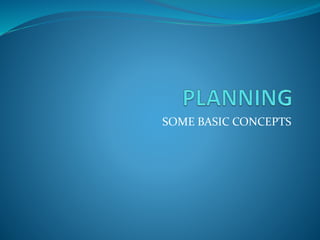Planning, some basic concepts
•Als PPTX, PDF herunterladen•
4 gefällt mir•1,150 views
this work will help the learners to understand planning. and readers will know its importance.
Melden
Teilen
Melden
Teilen

Empfohlen
Weitere ähnliche Inhalte
Was ist angesagt?
Was ist angesagt? (20)
Andere mochten auch
Dirección de marketing
Público objetivo
Identidad Corporativa y publicidad
Imagen corporativa
La marca
Que proporciona
Donde se establece
Factores memorizantes de la marca.
Diferencias entre marca y patente.
Tipos de marca
Partes de una marca
Imagen corporativa.
Decisiones para crear una marca
Branding
Lovemark
Tips para la óptima construcción de tu marca
Labor en equipo
MARKETING – Clase 08 – Dirección de marketing. Imagen corporativa. La MARCA. ...

MARKETING – Clase 08 – Dirección de marketing. Imagen corporativa. La MARCA. ...LEOnardo AMARaldo DELgado
Andere mochten auch (20)
Mixed use development and its usefulness in the region - Webinar

Mixed use development and its usefulness in the region - Webinar
MARKETING – Clase 08 – Dirección de marketing. Imagen corporativa. La MARCA. ...

MARKETING – Clase 08 – Dirección de marketing. Imagen corporativa. La MARCA. ...
Topics: Graft and Corruption/Bribery /Cyber Crime: Should there be a law agai...

Topics: Graft and Corruption/Bribery /Cyber Crime: Should there be a law agai...
Strategic Planning: Concepts Theories and Practices

Strategic Planning: Concepts Theories and Practices
Ähnlich wie Planning, some basic concepts
Ähnlich wie Planning, some basic concepts (20)
Educational Planning (Notes-Makerere) PPT [Autosaved].pptx![Educational Planning (Notes-Makerere) PPT [Autosaved].pptx](data:image/gif;base64,R0lGODlhAQABAIAAAAAAAP///yH5BAEAAAAALAAAAAABAAEAAAIBRAA7)
![Educational Planning (Notes-Makerere) PPT [Autosaved].pptx](data:image/gif;base64,R0lGODlhAQABAIAAAAAAAP///yH5BAEAAAAALAAAAAABAAEAAAIBRAA7)
Educational Planning (Notes-Makerere) PPT [Autosaved].pptx
Kürzlich hochgeladen
https://app.box.com/s/x7vf0j7xaxl2hlczxm3ny497y4yto33i80 ĐỀ THI THỬ TUYỂN SINH TIẾNG ANH VÀO 10 SỞ GD – ĐT THÀNH PHỐ HỒ CHÍ MINH NĂ...

80 ĐỀ THI THỬ TUYỂN SINH TIẾNG ANH VÀO 10 SỞ GD – ĐT THÀNH PHỐ HỒ CHÍ MINH NĂ...Nguyen Thanh Tu Collection
Mehran University Newsletter is a Quarterly Publication from Public Relations OfficeMehran University Newsletter Vol-X, Issue-I, 2024

Mehran University Newsletter Vol-X, Issue-I, 2024Mehran University of Engineering & Technology, Jamshoro
Kürzlich hochgeladen (20)
Python Notes for mca i year students osmania university.docx

Python Notes for mca i year students osmania university.docx
Sensory_Experience_and_Emotional_Resonance_in_Gabriel_Okaras_The_Piano_and_Th...

Sensory_Experience_and_Emotional_Resonance_in_Gabriel_Okaras_The_Piano_and_Th...
Fostering Friendships - Enhancing Social Bonds in the Classroom

Fostering Friendships - Enhancing Social Bonds in the Classroom
Kodo Millet PPT made by Ghanshyam bairwa college of Agriculture kumher bhara...

Kodo Millet PPT made by Ghanshyam bairwa college of Agriculture kumher bhara...
Food safety_Challenges food safety laboratories_.pdf

Food safety_Challenges food safety laboratories_.pdf
Salient Features of India constitution especially power and functions

Salient Features of India constitution especially power and functions
General Principles of Intellectual Property: Concepts of Intellectual Proper...

General Principles of Intellectual Property: Concepts of Intellectual Proper...
ICT Role in 21st Century Education & its Challenges.pptx

ICT Role in 21st Century Education & its Challenges.pptx
80 ĐỀ THI THỬ TUYỂN SINH TIẾNG ANH VÀO 10 SỞ GD – ĐT THÀNH PHỐ HỒ CHÍ MINH NĂ...

80 ĐỀ THI THỬ TUYỂN SINH TIẾNG ANH VÀO 10 SỞ GD – ĐT THÀNH PHỐ HỒ CHÍ MINH NĂ...
Planning, some basic concepts
- 2. PLANNING Planning is preparing a sequence of action steps to achieve some specific goal If you do it effectively, you can reduce much the necessary time and effort of achieving the goal.
- 3. PLANNING A plan is like a map. When following a plan, you can always see how much you have progressed towards your project goal and how far you are from your destination. Knowing where you are is essential for making good decisions on where to go or what to do next.
- 4. PLANNING Planning is also crucial for meeting your needs during each action step with your time, money, or other resources. With careful planning you often can see if at some point you are likely to face a problem. It is much easier to adjust your plan to avoid or smoothen a coming crisis, rather than to deal with the crisis when it comes unexpected.
- 6. Planning Provides Direction: Under the process of planning the objectives of the organization are defined in simple and clear words. The obvious outcome of this is that all the employees get a direction and all their efforts are focused towards a particular end. In this way, planning has an important role in the attainment of the objectives of the organization.
- 7. Planning Reduces Risks of Uncertainty: Planning is always done for future and future is uncertain. With the help of planning possible changes in future are anticipated and various activities are planned in the best possible way. In this way, the risk of future uncertainties can be minimized.
- 8. Planning Reduces Overlapping and Wasteful Activities: Under planning, future activities are planned in order to achieve objectives. Consequently, the problems of when, where, what and why are almost decided. This puts an end to disorder and suspicion. In such a situation coordination is established among different activities and departments.
- 9. Planning Promotes Innovative Ideas: It is clear that planning selects the best alternative out of the many available All these alternatives do not come to the manager on their own, but they have to be discovered. While making such an effort of discovery, many new ideas emerge and they are studied intensively in order to determine the best out of them.
- 10. Planning Facilitates Decision Making: Under it, a variety of alternatives are discovered and the best alternative is chosen. The planning sets the target for decision making. It also lays down the criteria for evaluating courses of action. In this way, planning facilitates decision making.
- 11. Planning Establishes Standards for Controlling: By determining the objectives of the organization through planning all the people working in the organization and all the departments are informed about ‘when’, ‘what’ and ‘how’ to do things.
